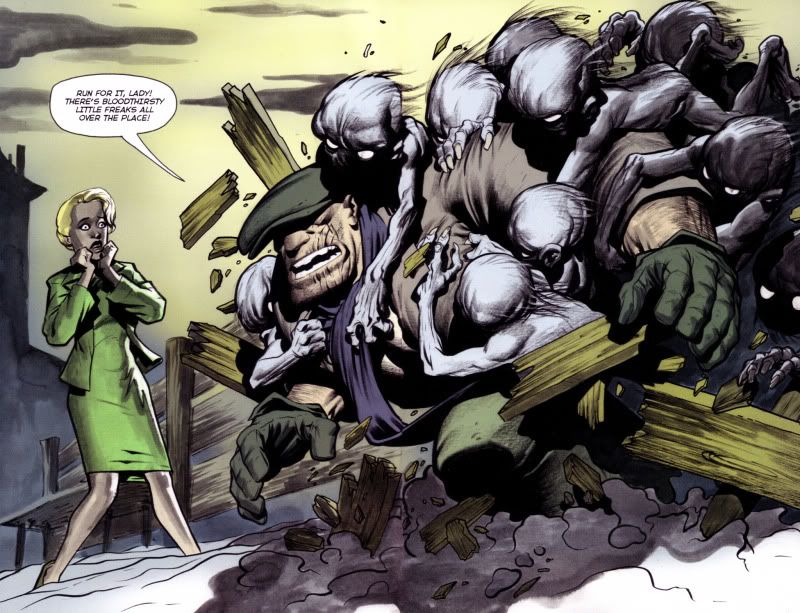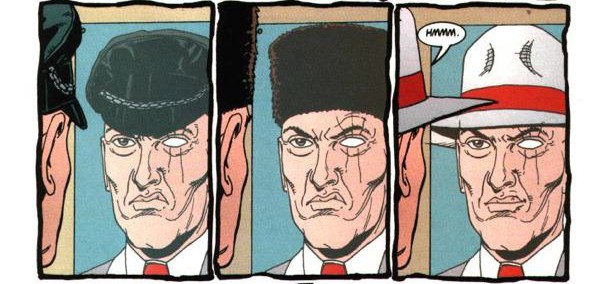
A bit of a cheat, this panel's actually a 2-page spread
Eric Powell’s The Goon is an achievement in itself. You’ve heard this story before – aspiring comic creator comes up with a character idea that evolves from doodles on sketchpads to something more fully-fleshed-out, the pitch is rejected by mainstream comic publishers, creator improves on his ideas, self-publishes his comic, and a phenomenon is born. The only variant to this starry-eyed story is that Powell’s creation was first published by Avatar Press at first as a black-and-white series, and after three issues, Powell stopped producing new material, waited for the contract to expire and then began to self-publish the series himself. By this time, the positive buzz on his horror-comedy series was high enough for Dark Horse comics to come a-knocking at his door, apologetic about passing on his series the first time he pitched it to them. The very first issue of the Dark Horse debut won him an Eisner for “Best Single Issue” in 2004, and since then, Powell’s been getting better and better. The Goon has consistently maintained its balance of outrageous farce, over-the-top violence and fine storytelling and the artist himself has evolved considerably since the early Avatar days.
Because the series is mostly a one-man show, Powell allows himself to indulge in all kinds of visual experimentation in his issues. His art style, once rough and punctuated by scratchy inks, morphed into a lush painterly look as he began to use ink washes. His figures have a three-dimensional quality, as you can see in the panel above. The backgrounds are very understated, and it’s interesting to note how much he manages to imply with his minimal strokes and shades. Look at the background closely. A few clouds, the outline of an house, both rendered with a smoky feel that brings out more character in this snow-covered scene than a million spelled-out details ever could. At this stage, Powell was doing everything, including the colors – and oh good God, the colors are gorgeous! They do not have the murkiness that you see in many modern comics, the over-use of photoshop filters that end up making the final product look kitschy or just too dark to make out anything. ( The colors are now done by Dark Horse veteran Dave Stewart, to allow Powell more time to concentrate on the story and the art. )
Just like Mike Mignola does in Hellboy, Powell uses a very distinct look for his lead character, Goon, who’s the one hurtling through the fence above. The character’s appearance is fairly unchanged throughout, the cap shielding his eyes, the scar across his face, the gloves, the working-john’s clothes – in a way, I think of the Goon as the twenty-first century version of Popeye ( and I refer to the original the Segar strips here ), a laconic, violent rough-neck who can take a punch and dish it right back, with an extra one thrown in for luck. You can be sure that all these blood-thirsty little freaks get their just desserts in the next couple of pages.
Part of the appeal of this particular panel – yeah, ok, two-page spread – is the way the violence intrudes into the reader’s ken. The few pages that lead to this one is a slow set-up, featuring a nifty tribute to a memorable sequence in Alfred Hitchcock’s The Birds, in which Tippi Hedren is smoking near the school and the birds begin to congregate, slowly, on the jungle gym. Here, it’s the lady you see in this panel and these vicious-looking creatures gathering around as she smokes a cigarette – you don’t know anything about her, just that something bad is about to happen, and you mentally prepare yourself for the inevitable end to which unknown supporting characters are subjected to in examples of the horror genre. And then Powell has to go and introduce our burly protagonist in a spectacular fashion, shattering genre conventions, and our expectations in this magnificient panel.
Do yourself a favour, and pick up The Goon. The early Avatar issues are a little rough, but by the time you come across this panel, you will be ready to worship Eric Powell. And while I know this sounds very cliche, The Goon just keeps getting better and better, as Powell begins tampering with the status quo he has laid down in the initial years of his saga.







